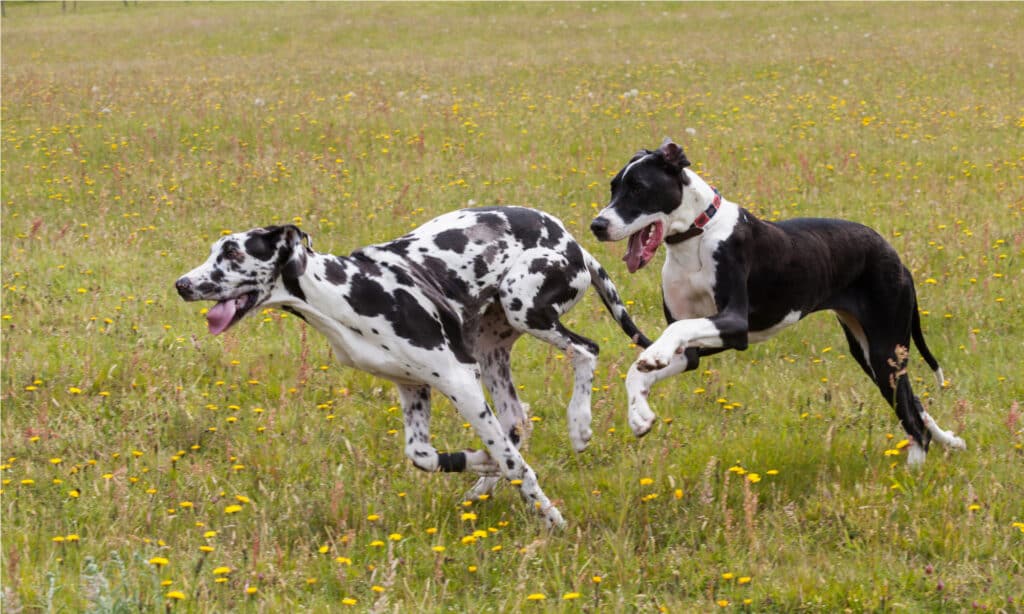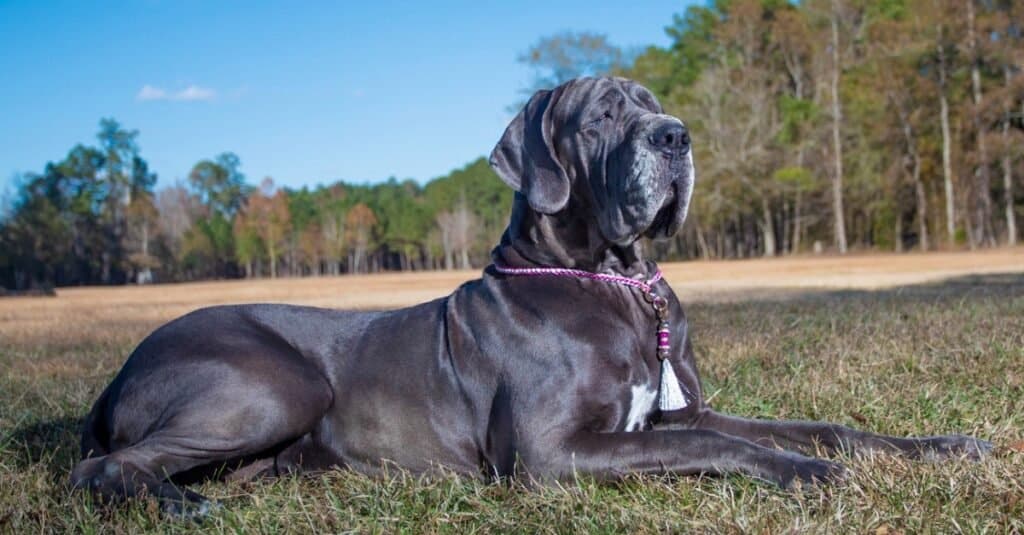The Great Dane is cherished for its towering stature and gentle giant heart. But behind this dog’s appearance and loving personality lies an unfortunate list of health issues. Due to their size and complex genetics, Great Danes are prone to several health problems, which include bloat, heart disease, and even hip dysplasia.
Did you know that these genetic issues result in shortening their life span? This explains why some only reach an age of six or seven years old. Read on as A-Z Animals will provide insight into common health problems in Great Danes. You will gain important knowledge to ensure that your beautiful canine leads a happy and healthy life.

Possible Great Dane health problems include Addison’s Disease.
©hedgehog94/Shutterstock.com
1. Addison’s disease
Addison’s disease, also referred to as hypoadrenocorticism, is a significant health problem that impacts large dog breeds such as Great Danes. It arises when the adrenal glands are responsible for generating hormones that regulate functions. However, the adrenal glands fail to produce an adequate quantity of cortisol and aldosterone.
Diagnosing Addison’s disease requires conducting blood tests to assess cortisol and electrolyte levels. Standard treatment usually entails administering hormone replacement therapy by injecting medication monthly. Additionally, these medications alleviate symptoms, enabling your dog to live a normal life.
Symptoms of Addison’s disease
- Lethargy
- Weight loss
- Always feeling thirsty
- Frequent urination
- Diarrhea
- Vomiting
- Pain in abdomen
- Hair loss
- Shaking
2. Hyperthyroidism
Hypothyroidism occurs when a dog’s thyroid gland fails to produce the hormones for regulating its metabolism and other essential bodily functions. The thyroid gland plays a role in managing your Great Dane’s energy levels, weight, and coat health.
Furthermore, diagnosing hypothyroidism involves a series of blood tests aimed at evaluating the levels of thyroid hormones. In some instances, extra examinations, like thyroid antibody tests, might be necessary. After receiving a diagnosis, the prescribed treatment typically comprises providing supplements of thyroid hormones to address the deficiency.
Symptoms of Hypothyroidism
- Weight gain or weight loss
- Hair loss
- Dry skin
- Intolerance to cold
- Muscle weakness
3. Bloat and Gastric problems
Bloat, which is also called dilation volvulus, is a potentially life-threatening condition that impacts Great Danes. This happens when the stomach becomes filled with gas, causing it to enlarge and twist. This twisting results in the interruption of blood flow to the stomach and other essential organs, causing tissue damage and shock.
Their large size and deep chests can make the breed more prone to experiencing bloat. Therefore, take measures by providing your Great Dane with raised feeding bowls and avoid physical activity right after eating. In fact, this could lower their chances of developing a twisted stomach. It’s one small way to reduce the risk of a major Great Dane health problem.
Symptoms of Bloat
- Abnormal panting
- Enlarged stomach
- Diarrhea
- Restlessness
- Pale gums
- Excessive drooling
- Whining
- Dry heaving

Avoid physical activity right after eating. In fact, this lowers the chance of developing a twisted stomach.
©Claire Plumridge/Shutterstock.com
4. Hip Dysplasia
Hip dysplasia is a genetic issue that impacts health problems in Great Danes. It occurs due to a development of the hip joint, resulting in a misalignment between the ball and socket of the joint. Therefore, this causes strain on the joint, leading to discomfort, swelling, and reduced mobility as time goes by.
A vet may recommend steroidal anti-inflammatory medications to help with pain and inflammation. Also, incorporating a regulated exercise regimen that assists in strengthening muscles and maintaining joint mobility. Followed by joint supplements containing glucosamine, chondroitin, and omega-3 to be included in a healthy diet regime.
Symptoms of Hip Dysplasia
- Lameness
- Limping
- Difficulty standing up or lying down
- Stiffness
- Severe pain
- Change in posture
- Clicking joints
5. Heart disease
Dilated Cardiomyopathy and Aortic Stenosis lurk in the genetic makeup of Great Danes. DCM refers to a condition where the heart muscles weaken and enlarge, affecting their efficiency in pumping blood. In addition, Aortic Stenosis restricts blood flow caused by the narrowing of the aortic valve, thereby putting extra strain on the heart.
Veterinarians often prescribe medications to slow down the growth of this disorder. Although these treatments may not guarantee a full recovery, however, these medications will prolong the lifespan of your Great Dane.
Symptoms of Heart disease
- Shallow breathing
- Fainting
- Decreased appetite
- Lethargy
- Coughing during exercising
6. Osteosarcoma
Osteosarcoma is known for its aggressive and quick-spreading nature. This form of cancer affects the bones of your Great Dane’s limbs, leading to bone deterioration and abnormal tissue growth.
The approach to osteosarcoma treatment involves performing an operation to remove the affected leg and then administering chemotherapy to prevent the cancer from spreading to areas of the body. Despite undergoing treatment, the prognosis can be uncertain due to the cancer’s tendency to metastasize.
Symptoms of Osteosarcoma
- Tiredness
- Weight loss
- Severe bone pain
- Weakened bones
- Visible lumps
- Stiff joints

The prognosis of Osteosarcoma causes tiredness and stiff joints in Great Danes.
©iStock.com/gsagi
7. Epilepsy
Epilepsy is a condition that affects the brain due to bursts of activity. Seizures can vary in strength and length, ranging from instances of staring or temporary confusion. In addition, severe epileptic convulsions result in uncontrollable movements. This disorder is treated with medication with the goal of minimizing the occurrence of severe seizures.
Symptoms of Epilepsy
- Convulsions
- Muscles twitching
- Confusion
- Tiredness
- Restlessness
8. Eye conditions
Ectropion and entropion are two eye conditions that can sometimes affect Great Danes. Ectropion occurs when the eyelids turn outward, exposing the part of the eyelid. Whereas Entropion is the complete opposite. The eyelids curl inward and cause the eyelash hair to rub against the cornea.
Symptoms of Ectropion and Entropion
- Dryness
- Irritation
- Redness
- Occurring eye infections
The photo featured at the top of this post is © verky01/Shutterstock.com
Ready to discover the top 10 cutest dog breeds in the entire world?
How about the fastest dogs, the largest dogs and those that are -- quite frankly -- just the kindest dogs on the planet? Each day, AZ Animals sends out lists just like this to our thousands of email subscribers. And the best part? It's FREE. Join today by entering your email below.
Thank you for reading! Have some feedback for us? Contact the AZ Animals editorial team.







